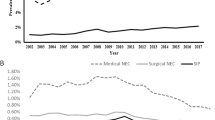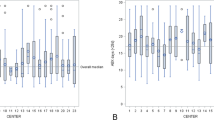Abstract
Objective:
Mother’s own milk and donor human milk use is increasing as a means of necrotizing enterocolitis (NEC) prevention. Early onset of enteral feeding has been associated with improvement of many outcomes but has not been shown to reduce the incidence of NEC. Better definition of the window of risk for NEC by gestational strata should improve resource management with respect to donor human milk and enhance our understanding of NEC timing and pathogenesis. Our objective was to establish a NEC dataset of sufficient size and quality, then build a generalizable model of NEC onset from the dataset across gestational strata.
Study Design:
We used de-identified data from the Pediatrix national dataset and filtered out all diagnostic confounders that could be identified by either specific diagnoses or logical exclusions (example dual diagnoses), with a specific focus on NEC and spontaneous intestinal perforation (SIP) as the outcomes of interest. The median day of onset was plotted against the gestational age for each of these diagnoses and analyzed for similarities and differences in the day of diagnosis.
Result:
Onset time of medical NEC was inversely proportional to gestation in a linear relationship across all gestational ages. We found the medical NEC dataset displayed characteristics most consistent with a homogeneous disease entity, whereas there was a skew towards early presentation in the youngest gestation groups of surgical NEC (suggesting probable SIP contamination).
Conclusion:
Our national dataset demonstrates that NEC onset occurs in an inverse stereotypic, linear relationship with gestational age at birth. Medical NEC is the most reliable sub-cohort for the purpose of determining the temporal window of NEC risk.
This is a preview of subscription content, access via your institution
Access options
Subscribe to this journal
Receive 12 print issues and online access
$259.00 per year
only $21.58 per issue
Buy this article
- Purchase on Springer Link
- Instant access to full article PDF
Prices may be subject to local taxes which are calculated during checkout



Similar content being viewed by others
References
Aschner JL, Deluga KS, Metlay LA, Emmens RW, Hendricks-Munoz KD . Spontaneous focal gastrointestinal perforation in very low birth weight infants. J Pediatr 1988; 113 (2): 364–367.
Attridge JT, Clark R, Walker MW, Gordon PV . New insights into spontaneous intestinal perforation using a national data set: (2) two populations of patients with perforations. J Perinatol 2006; 26 (3): 185–188.
Gonzalez-Rivera R, Culverhouse RC, Hamvas A, Tarr PI, Warner BB . The age of necrotizing enterocolitis onset: an application of Sartwell's incubation period model. J Perinatol 2011; 31 (8): 519–523.
Gordon P, Rutledge J, Sawin R, Thomas S, Woodrum D . Early postnatal dexamethasone increases the risk of focal small bowel perforation in extremely low birth weight infants. J Perinatol 1999; 19 (8 Pt 1): 573–577.
Gordon PV, Young ML, Marshall DD . Focal small bowel perforation: an adverse effect of early postnatal dexamethasone therapy in extremely low birth weight infants. J Perinatol 2001; 21 (3): 156–160.
Gordon PV, Swanson JR, Attridge JT, Clark R . Emerging trends in acquired neonatal intestinal disease: is it time to abandon Bell's criteria? J Perinatol 2007; 27 (11): 661–671.
Gordon PV . Understanding intestinal vulnerability to perforation in the extremely low birth weight infant. Pediatr Res 2009; 65 (2): 138–144.
Gordon P, Thibeau S, Pennier C, Ginsberg H, Lunyong V, Cortez M et al. Is lymphocytosis an adjunct predictor of NEC mortality in low gestation infants? EJ Neonatol Res 2012; 2: 29–36.
Bohnhorst B, Kuebler JF, Rau G, Gluer S, Ure B, Doerdelmann M . Portal venous gas detected by ultrasound differentiates surgical NEC from other acquired neonatal intestinal diseases. Eur J Pediatr Surg 2011; 21 (1): 12–17.
Eaton S, Sebire N, Thyoka M, Pierro A . Histologic and immunohistochemical features associated with outcome in neonatal necrotizing enterocolitis. Eur J Pediatr Surg 2014; 24 (1): 51–56.
Gordon P, Christensen R, Weitkamp JH, Maheshwari A . Mapping the new world of necrotizing enterocolitis. EJ Neonatol Res 2012; 2: 145–172.
Vermont Oxford Network. Vermont Oxford Network Database Manual of Operations: Part 2: Data definitions and data forms for infants born in 2013, R Release 17 ed, 2012.
Hummler H . Benchmarking in neonatal intensive care: obstetrical and neonatal practices and registration policies may influence outcome data. Arch Dis Child Fetal Neonatal Ed 2013; 98 (2): F96–F97.
Attridge JT, Herman AC, Gurka MJ, Griffin MP, McGahren ED, Gordon PV . Discharge outcomes of extremely low birth weight infants with spontaneous intestinal perforations. J Perinatol 2006; 26 (1): 49–54.
Wadhawan R, Oh W, Hintz SR, Blakely ML, Das A, Bell EF et al. Neurodevelopmental outcomes of extremely low birth weight infants with spontaneous intestinal perforation or surgical necrotizing enterocolitis. J Perinatol 2014; 34 (1): 64–70.
Swanson JR, Attridge JT, Gordon PV . Potential confounder of NEC clinical trials. J Perinatol 2009; 29: 256–257.
Ehrenkranz RA, Das A, Wrage LA, Poindexter BB, Higgins RD, Stoll BJ et al. Early nutrition mediates the influence of severity of illness on extremely LBW infants. Pediatr Res 2011; 69 (6): 522–529.
Leaf A, Dorling J, Kempley S, McCormick K, Mannix P, Linsell L et al. Early or delayed enteral feeding for preterm growth-restricted infants: a randomized trial. Pediatrics 2012; 129 (5): e1260–e1268.
Morgan J, Young L, McGuire W . Delayed introduction of progressive enteral feeds to prevent necrotising enterocolitis in very low birth weight infants. Cochrane Database Syst Rev 2013; 5: CD001970.
Morgan J, Bombell S, McGuire W . Early trophic feeding versus enteral fasting for very preterm or very low birth weight infants. Cochrane Database Syst Rev 2013; 3: CD000504.
Christensen RD, Lambert DK, Baer VL, Gordon PV . Necrotizing enterocolitis in term infants. Clin Perinatol 2013; 40 (1): 69–78.
Lambert DK, Christensen RD, Henry E, Besner GE, Baer VL, Wiedmeier SE et al. Necrotizing enterocolitis in term neonates: data from a multihospital health-care system. J Perinatol 2007; 27 (7): 437–443.
Blau J, Calo JM, Dozor D, Sutton M, Alpan G, La Gamma EF . Transfusion-related acute gut injury: necrotizing enterocolitis in very low birth weight neonates after packed red blood cell transfusion. J Pediatr 2011; 158 (3): 403–409.
Christensen RD, Lambert DK, Henry E, Wiedmeier SE, Snow GL, Baer VL et al. Is ‘transfusion-associated necrotizing enterocolitis’ an authentic pathogenic entity? Transfusion 2010; 50 (5): 1106–1112.
El-Dib M, Narang S, Lee E, Massaro AN, Aly H . Red blood cell transfusion, feeding and necrotizing enterocolitis in preterm infants. J Perinatol 2011; 31 (3): 183–187.
Josephson CD, Wesolowski A, Bao G, Sola-Visner MC, Dudell G, Castillejo MI et al. Do red cell transfusions increase the risk of necrotizing enterocolitis in premature infants? J Pediatr 2010; 157 (6): 972–978.
Mohamed A, Shah PS . Transfusion associated necrotizing enterocolitis: a meta-analysis of observational data. Pediatrics 2012; 129 (3): 529–540.
Paul DA, Mackley A, Novitsky A, Zhao Y, Brooks A, Locke RG . Increased odds of necrotizing enterocolitis after transfusion of red blood cells in premature infants. Pediatrics 2011; 127 (4): 635–641.
Acknowledgements
Funding Source: No funding secured for this study.
Author information
Authors and Affiliations
Corresponding author
Ethics declarations
Competing interests
The authors declare no conflict of interest.
Rights and permissions
About this article
Cite this article
Gordon, P., Clark, R., Swanson, J. et al. Can a national dataset generate a nomogram for necrotizing enterocolitis onset?. J Perinatol 34, 732–735 (2014). https://doi.org/10.1038/jp.2014.137
Received:
Revised:
Accepted:
Published:
Issue Date:
DOI: https://doi.org/10.1038/jp.2014.137
This article is cited by
-
Spontaneous intestinal perforation (SIP) will soon become the most common form of surgical bowel disease in the extremely low birth weight (ELBW) infant
Journal of Perinatology (2022)
-
Characteristics and outcomes of a multi-institution cohort of infants with necrotizing enterocolitis totalis
Journal of Perinatology (2022)
-
Neonatal necrotizing enterocolitis: a case series examining clinical diagnosis with discrepant versus concordant autopsy results
Journal of Perinatology (2020)
-
Defining necrotizing enterocolitis: current difficulties and future opportunities
Pediatric Research (2020)
-
Bifidobacterium and Lactobacillus for preventing necrotizing enterocolitis in very-low-birth-weight preterm infants: a systematic review and meta-analysis
World Journal of Pediatrics (2020)



